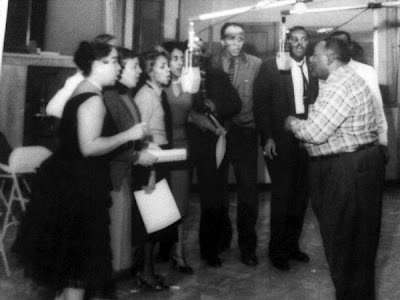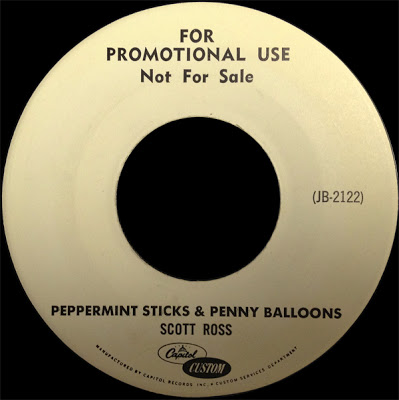Here’s proof that there’s still more buried treasure waiting to be found in those boxes of old vinyl records that live in dusty attics and garages across America! While helping a good friend clean out her dusty garage in Dallas, Texas, we stumbled upon several custom pressings and a couple acetates that were recorded by her late husband, Scott Ross. There were a total of fourteen different recordings, and I hadn’t heard any of them before. In fact, I didn’t even know they existed. That’s a bit unusual, considering the fact that I’ve seen millions of records in my life!
Listen to Special Date by Scott Ross on Capitol Custom 2593-2594 from 1959:
The artist is Scott Francis Ross, born on 6 October 1936 in the Queen of Angels Hospital in Los Angeles, California. Scott was named after his father, Scott Cunningham, who died just two years after he was born. Scott’s very lovely mother, Ruth, was a private nurse. She eventually got remarried to a doctor named Donald Ross and young Scott Cunningham became Scott Ross. Scott’s new step-father had started a medical group called Ross-Loos Medical Center in 1929 with his partner H. Clifford Loos, whose younger sister Anita Loos created the book that became the movie Gentlemen Prefer Blondes starring Marilyn Monroe. The Ross-Loos group is famous for being the very first Health Maintenance Organization (HMO) in the country. Needless to say, Dr. Donald Ross became a very rich man.
Raised in the Catholic faith, Scott attended Loyola High School in Los Angeles. Scott and his friend John Valenzuela somehow ended up dating the same girl at the same time. Her name was Harma. She must have mixed up her schedules and invited both of them to pick her up for a date on the same night. Scott and John came to her front door at exactly the same time. When Harma’s father told her there were two gentlemen here to see her, Harma must have freaked out! John Valenzuela ended up marrying a girl named Nancy who’s sister was Patricia Ann Priest, one of the girls who played Marilyn on The Munsters. Scott would later become Godfather to John and Nancy’s two children.
After graduating from high school in 1954, Scott attended the University of Arizona to study business administration. This didn’t sit well with his step-father, who would have preferred that Scott follow in his footsteps and become a doctor. But Scott had a passion for business and a natural talent for sales. While in college, Scott picked up the nickname “Hollywood” from his friends. He drove around in a Cadillac convertible that his parents bought for him. A college buddy of Scott’s from Texas named John attached a huge set of bull horns to Scott’s car to give it a “Texas” look.
Scott’s parents lived in the Los Feliz area of Los Angeles up near Griffith Park. It was an area known as “Pill Hill” because so many doctors lived in that neighborhood. They lived at 2227 Chislehurst Drive, about a mile northeast of Hollywood and Vine. After graduating from college in 1958, Scott returned to Los Angeles. He cut these records in late 1958 and early 1959, probably with the hopes of landing a recording contract with a major label.
The oldest record I found by Scott is an acetate made at the Gold Star Studios located at 6252 Santa Monica Boulevard in Hollywood just west of Vine, the same place where Brian Wilson and The Beach Boys recorded the album Pet Sounds, Ritchie Valens recorded La Bamba, and Phil Spector perfected his “Wall of Sound” production technique. The second acetate was cut at Radio Recorders located at 7000 Santa Monica Boulevard in Hollywood. This was considered the finest studio in Los Angeles at the time and was used extensively by several major labels including Capitol, Columbia, RCA Victor, and Decca. You might have heard of some of the folks who recorded there, such as Charlie Parker, Elvis Presley, Frank Zappa, Jimi Hendrix, The Carpenters, Louis Armstrong, and many others. The acetates were both 78 RPM pressings.
By my estimation, the first 45 RPM single Scott made was pressed on the Audio Arts label. The rest of his records were pressed on the Capitol Custom label. When you listen to all fourteen songs, you can clearly hear his voice mature and the production quality improve. It’s clear from these recordings that Scott had a wonderful voice. The backing musicians did a superb job as well, and I think I know who they might have been.
Scott’s 45 RPM recording of Special Date credits Red Callender as the arranger. Red’s real name was George Sylvester, and he was an incredibly talented double bass player who could also blow a mean tuba. He played for Louis Armstrong back in the 1930’s and mentored Charlie Mingus. Around the time Scott was making these records, a trio of very fine African American musicians were working as studio musicians at Gold Star Studios, none other than the legendary Ernie Freeman on piano, René Hall on guitar, and Plas Johnson on saxophone, who recorded Sax Fifth Avenue under the name Johnny Beecher in 1963 that reached #65 on the charts. There’s a very good chance that these three gentlemen, with help on bass from Red, laid down the backing instrumental tracks on Scott’s recordings!
Scott’s later records definitely had hit potential, but there’s a good chance they were overlooked because he sounded a bit too much like many other hit makers at that time.
Would you like to hear a few more of Scott’s recordings? Here’s My Little Annette by Scott Ross on Capitol Custom 2593-2594 from 1959:
Here’s Trip To Chicago by Scott Ross on Capitol Custom 2593-2594 from 1959.
Here’s Write Me One Letter by Scott Ross on Capitol Custom 2121-2122 from 1959:
Here’s Peppermint Sticks And Penny Balloons by Scott Ross on Capitol Custom 2121-2122 from 1959:
My guess is that this record is the one Scott was banking on to be a hit. Here’s Satisfied by Scott Ross on Capitol Custom 2123-2124 from 1959:
Scott wasn’t quite in the Teener groove when he laid down this early track. Here’s Jerry by Scott Ross on Audio Arts 140 from 1959:
The audio quality on this one isn’t the best. That’s because it came from a 78 RPM acetate. On both of acetate discs I found, Scott had covered the track on one side with white tape with the words “Do Not Play” written on it. I was able to carefully peel off the tape and remove a lot of the glue, actually getting these damaged records to play well enough to record. This song, a cover of St James Infirmary by Scott Ross, was on the undamaged side of his Radio Recorders acetate, probably from 1958 or 1959:
There were two different versions of both Special Date and Satisfied. An earlier version of Special Date was issued on Capitol Custom 2123-2124 and also on this acetate and featured a backing chorus. I think the later one without the chorus is much better. The earlier version of Satisfied on the Gold Star acetate is a completely different mix with more of a jazz arrangement.
Scott landed a job with Disney’s Buena Vista Records around the time he made these records. During his time with Disney, he rose to become National Sales Manager.
A&M Records was started by Herb Alpert and Jerry Moss in 1962. It was first called Carnival Records, but quickly changed when they learned of another label using that name. Scott Ross was hired by the company and worked his way up to West Coast Sales Manager. When A&M Records first started, Jerry Moss asked his friend Nate Duroff, owner of the Monarch Pressing Plant in Los Angeles, if he would be willing to give him $35,000 credit so he could press 350,000 of their initial platters. Nate agreed to help his friend. Nate Duroff and Scott Ross also became very good friends. A lot of people in the business thought that A&M Records would be a flash in the pan and that Herb’s Tijuana Brass would be unlikely to score more hits. But they hung in there and made it work. They picked up some great artists along the way, too, such as The Carpenters, Supertramp, and Cat Stevens.
Around 1969, Scott bought a boat and joined the Balboa Bay Club in Newport Beach, California. It was there where he met his future wife, Melanie James. Scott was 33 at the time and Melanie was only nine years old. Scott had a lot of girlfriends, but he was particularly fond of Melanie. Scott’s friends would often ask him why he wasn’t married and he’d always reply, “I’m waiting for Melanie!” When Melanie turned 19, she and Scott were married on 22 September 1979. Scott and Melanie raised two daughters, Amanda and Bridget.
Scott left A&M Records to become West Coast Sales Manager for Warner-Elektra-Atlantic Records in November 1970. Just five months later, Elektra opened a huge new studio office building complex.
At some point, Scott began working with MGM Records where he had a hand in the promotion of Candy Man by Sammy Davis Junior, The Osmonds, and many others. The gold records found in his garage attest to the fact that Scott really loved music and did an excellent job promoting and selling records.
In 1974, Scott became West Coast Sales Manager for Nate Duroff’s Viewlex-Monarch pressing company in Los Angeles. At the time, due to an Arab oil embargo, Viewlex was having problems getting enough plastic needed for their vinyl record pressings.
In late 1986, a Japanese joint-venture of Mitsubishi and ElectroSound Group began building a large compact disc and record pressing plant in the Dallas suburb of Plano under the name Memory-Tech. When they bought out Viewlex-Monarch in 1988, Scott stayed with the new company, but he was forced to relocate with his family to Texas. Memory-Tech was later purchased by an Australian company called Disctronics, which also used the names DiscUSA and U-Tech. In May 1995, the company became involved in a huge lawsuit alleging that Disctronics, Sony, Philips, Discovision and Pioneer had conspired to monopolize CD production and manufacturing. That lawsuit was finally settled in 1999 following a four-year legal battle. At some point during all this, displeased with the new management, Scott left the company to become head of operations for the Dallas National Golf Club.
In December 2009, Scott Ross was diagnosed with pancreatic cancer. Eventually he got too sick to continue working. He passed away on 13 August 2010 at age 74 and is buried Forest Lawn Cemetery on Harry Hines Boulevard in Dallas.
Now I’ve told you just about everything I could uncover about Scott Ross. You might wonder how I happened to be cleaning out his garage when I stumbled upon these rare records and photographs. Well, it turns out that Melanie Ross and I met a few months ago and began dating — and now you know “The Rest Of The Story!”
If you were in the record business and knew Scott Ross, maybe you can add some details to his story. We’d love to hear from you. By the way, all fourteen of the songs Scott Ross made have been added to the rotation on MusicMaster Oldies. Listen long enough and you’ll hear his entire catalog. Melanie Ross may even consider selling some of these rare platters at some point — for the right price!























